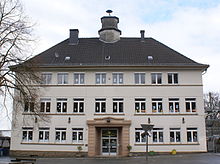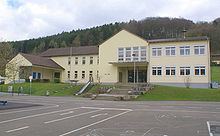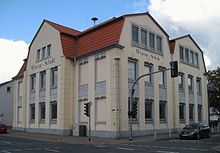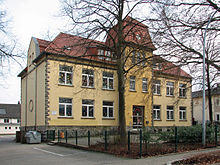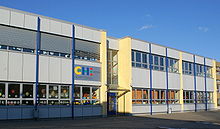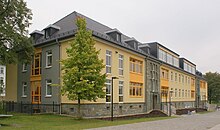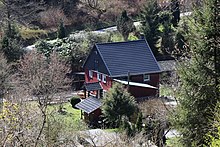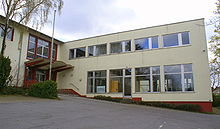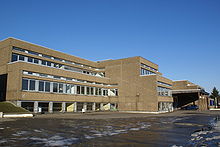Schools in Hemer
Schools in Hemer have existed since around 1600, when today's Woesteschule started teaching as a Protestant parish school. Previously, private tutors taught the children of wealthy Hemeran families in the houses. Today there are eight primary schools , one secondary school , one comprehensive school and one grammar school in the town of Hemer in North Rhine-Westphalia . In addition, the city is home to three special needs schools with different focuses.
The primary schools and the secondary school I (Urbecker Straße) emerged from former elementary schools . Most schools are run by the city of Hemer, the Wilhelm-Busch and Regenbogenschule by the Märkischer Kreis , the Felsenmeerschule by the Regional Association of Westphalia-Lippe .
history

A public school system in Hemer emerged in the course of the 17th century when the first elementary schools began teaching. In the first 200 years or so, increasingly after industrialization in the 19th century, there was a lack of space in all facilities, so that new elementary schools were built to reduce the size of the catchment area. Schools were also created in the rather sparsely populated valleys in the south of today's urban area, some of which were taught in a single class. Until the 1930s, the schools were exclusively denominational schools. The conversion to community schools during National Socialism was reversed after the war through parental votes.
The dispute over denominational or community schools in Hemer escalated into a school strike in 1957 , as the building of the Belgian school was awarded a community school after its departure. Since the denominational schools in the city center were overcrowded, and especially the building of the Catholic Brabeckschule was also in poor condition, they themselves claimed the building. After a heated special council meeting, the majority of the council around Mayor Karl Bode and city director Heinz Hoose essentially prevailed, but the importance of denominational schools remained due to a change in school districts.
As a result of the school reform in North Rhine-Westphalia in 1968, the existing elementary schools were converted into elementary and secondary schools and the denominational schools into community schools. The single primary schools in Brockhausen, Bredenbruch and Frönsberg were closed.
Elementary schools
Brabeck School
The Brabeckschule was founded in 1701 as the patronage school of the House of Hemer by Jobst Edmund von Brabeck , after he had the parish of St. Peter and Paul built there a year earlier . The sexton and organist of the parish church took over the teaching post of the Catholic school in Niederhemer, from which today's Brabeckschule developed. In the course of the Kulturkampf , this connection between sexton, organist and teacher was dissolved in 1887. In the 1840s , there was no longer enough space in the sexton's house , where lessons were held, which is why the space in a neighboring building was also used.
In 1864 a new building was erected opposite the sexton's house, which from then on was run as a girls' school. The Catholic parish of Hemers set up the school with its own teacher, independently of the existing school and without the support of the Protestant patron family Löbbecke, in order to continue to make orderly lessons possible with the steadily growing number of pupils. Although in 1877 the students from Sundwig, Westig and Deilinghofen changed to a Sundwig elementary school, the number of teachers in Niederhemer rose to three. The history of the patronage school ended ten years later, and since then the Catholic parish has been responsible for both schools.
By 1904 the number of pupils rose to 447 children who were looked after by six teachers. In the following years up to the First World War , the school buildings were renovated and partially expanded. In 1910 a branch was set up in a Protestant elementary school in Oberhemer . In 1914, the Becke district left the school network, so that the number of pupils fell to 377 children in 1929. Under the National Socialist regime, the school was run as a non-denominational Horst Wessel School , after the Second World War it was given its current name and was again converted into a denominational school. When an SPD member was appointed rector of the Catholic Brabeck School in 1947, the first school strike broke out in Hemer . The dispute between parents and the city council ended in 1951 with the appointment of a new headmaster. In 1957, the parents of the Brabeck students pushed for a second school strike to prevent the increased introduction of the community school in Hemer. In 1976 the city built a new building in Stübecken and took over responsibility for the elementary school, which has since been run again as a community elementary school . The previous building was canceled due to dilapidation . In 2004 the school introduced the open all day . The number of pupils was 181 in the 2008/2009 school year and 151 in 2019/2020.
Deilinghofen School
The Deilinghofen School was founded in the second half of the 17th century, continuity came in 1692 through the appointment of a new teacher who also took over the office of sexton . This amalgamation persisted in the following decades, the number of students remained roughly constant at 100. In the 19th century the number increased so that from 1838 onwards, teaching was carried out in two shifts. The first school in Deilinghofen, built around 1800, was located directly at the Stephanuskirche and was replaced by a new building in 1874. The building on today's Hönnetalstrasse is empty today, the first schoolhouse was rebuilt in Apricke . At the same time, after 1850 a second, and in 1877 a third, teaching post was set up. In 1909 the teacher's apartment was converted into a fourth classroom, with which a fourth teacher came to Deilinghofen. After the establishment of a fifth position as a teacher in 1920, the pairing of offices between sexton, organist and teacher ended in 1923 . The following year the school's only teacher was fired for financial reasons. As fewer and fewer children went to school during the global economic crisis , one job had to be cut.
After the irregular classes in World War II and the school closure at the end of the war, classes were resumed in September 1945. In 1948 the school was closed again for four months to accommodate refugees from the east. After classes were resumed, the school was named Bodelschwingh School and was run as a Protestant elementary school. With the growing number of students and teachers, a new building was necessary in the 1950s, which was opened in 1957 at the current location. When more than 300 pupils attended the Deilinghofen school in 1966, an extension with a gym and auditorium, completed in 1967, was necessary. A year later the elementary school was converted into a community elementary school. It was attended by 203 students in the 2009/2010 school year, and 195 students will be taught in the 2019/2020 school year.
Diesterweg School
The western school history began in August 1805 with the opening of a Protestant elementary school, which was housed in a one-story school building on today's Altenaer Strasse. Despite the building being expanded by one floor in 1827, there was not enough space to properly look after the rapidly growing number of students. After a house collection, a new building was built in 1870 and inaugurated the following year. At the same time, the school board set up a second teaching post. Towards the end of the 19th century, the primary school was expanded, but the space problems persisted, which is why a new school building was inaugurated in 1902. During a major renovation in 1930, the school was given its current appearance under the name Bismarck School . In the spring of 1904 the Catholic school Westig was founded. As a tenant, she was initially housed in the former building of the Protestant school until the new building in Wiehagen was opened in 1908 . The former Protestant school building was converted into an SA home in 1933 and demolished in 1970.
At the beginning of 1936, the western parents decided against the votes of many Catholic parents voluntarily to merge the two denominational schools. Although the district administrator of the Iserlohn district rejected this application, the Hemeran city administration unofficially merged the schools in 1937. A vocational school moved into the former Catholic school building . After the end of the war, the teachers gradually resumed classes from September 1945. In May 1946 the number of pupils was again at 474 children, who were looked after by six teachers. In April 1947, the parents voted for the reintroduction of denominational schools, and the facility was named after Adolph Diesterweg . The Catholic school moved back to its original building in Wiehagen in 1966, but merged again with the Protestant elementary school two years later. The primary school students of both denominations moved into the school building, which is still in use today, while the secondary school students were taught in Wiehagen. Today the building of the former Catholic elementary school serves as a residential building.
In the meantime, there is also a full-day offer in Westig, which is supported by the Friends of the Diesterweg School. The number of pupils was 109 in the 2009/2010 school year, and 140 in the 2019/2020 school year.
Freiherr vom Stein School
From 1737 there were official school lessons in Sundwig , which took place in private houses for the first few decades. Wealthy families had already hired hiking teachers beforehand to save their children the long way to school to Niederhemer . In 1803, the community acquired its first schoolhouse, which became too small in the following years due to the influx of industrial workers with school-age children. The municipality financed the purchase of a new piece of land in 1830 with entrance fees to the Heinrichshöhle and had a larger school building built. A further increase in the number of pupils led to the decision in 1876 to teach the pupils in shifts. In 1877, a Catholic school began teaching in Sundwig, which, with around 200 pupils, moved from an adjoining room to the mission church into a larger building in 1886. The space problems at the Protestant institution continued to increase, so that another new building was completed in 1894 and a second teacher was hired a year later. Two classrooms were added in 1906, when the bells of the Sundwiger Mission Church moved into the Protestant school.
In 1907 a public library opened in one of the classrooms . A second teacher was employed at the Catholic school in 1887 and a third in 1894. The opening of the Catholic school in Westig in 1908 brought a short-term improvement in the lack of space, but by 1920 the number of pupils was again over 200. In 1929, 221 children attended the Protestant school, five teachers were employed. The municipal council had therefore decided to build a new school when the municipalities of Sundwig, Westig and Hemer were merged. In the course of this, the school districts changed and one Sundwig pupil moved to Westig despite protests from parents. In 1936 the Protestant school was named after Wittekind , the Catholic one after Hans Schemm . The community school was introduced three years later and was overturned in 1946. At the same time, both schools were given the name Pestalozzi School . Ten years later, a school building for both Sundwig schools was inaugurated, which is now used by the free Protestant community in Hemer. The current name, Freiherr-vom-Stein -Schule, dates back to 1956 . At the end of the 1960s, the denominational schools were merged into a community elementary school, and the older classes were sent to Urbecker Strasse.
The school moved to its current building in 1995. Previously, the complex had been used as a school for Canadian, British and American children whose parents were military personnel stationed in Deilinghofen. The building became vacant after the last international troops withdrew. Today the Freiherr vom Stein primary school is the largest in the city. Open all-day operation has existed since 2005, the number of students was 276 in 2009/10 and 172 in 2019/2020.
His school
The Ihmert school children have been educated in the village since the second half of the 18th century. There is no longer any reliable source about the exact year it was founded, but lessons are documented for 1782. Between 1816 and 1817 the school was closed for over a year as there was no replacement for the deceased teacher. In 1825 the school moved into a new building, which ten years later again proved to be too small. The financial situation of the community made another new building impossible, so that only renovations were carried out. With the establishment of the school in Bredenbruch in 1878, the space problems were initially alleviated somewhat. In 1901 a new school building was completed, in which classes still take place today. The number of pupils then increased further from 99 in the 1900/01 school year to 119 pupils three years later. In the spring of 1906 a second classroom was built and a second teacher was hired.
Under the Nazi regime, the facility, which was henceforth run as a community elementary school, was called the Horst Wessel School. After the end of the war, the school was returned to its traditional status as a Protestant primary school. A third classroom was added to the school in 1948. Three years later, an additional building was built on the school premises, and in 1963 the building was expanded again. With the school reform in North Rhine-Westphalia, the Ihmerter elementary school was expanded into a non-denominational elementary and secondary school. At the same time, the school building in its current form was completed. The secondary school stayed in Ihmert until 1972, before students and teachers also moved to Urbecker Straße. In the 1990s, the Ihmerter school started an exchange program with a school in the French twin town of Beuvry , which is still running today after a break. A support association was established in 1992, and in 2006 the open day was introduced. In the 2009/2010 school year the number of students was 160, and in 2019/2020 there were 133.
Oesetalschule
The Becke municipal council began planning in 1882 to set up its own school. Almost 30 years later, in February 1911, it received the approval of the authorities. On April 21, 1914, Becke was the last municipality in the Iserlohn district to open an elementary school, which was named Kaiser Wilhelm School. A Catholic and a Protestant elementary school, each with one class, were housed in a newly constructed building. During the First World War, the denominational separation was temporarily lifted because both teachers were recalled to the army. The denominational schools, which had been independent since 1918, were merged again in 1939 to form the “unitary school” with the new name Dietrich-Eckart School. In April 1947, at the request of parents, denominational schools were reintroduced. A first extension was inaugurated in 1964. In October 1967 the two schools were reunited, and two years later they were converted into a community elementary school. The name Oesetalschule dates back to 1976. The last structural changes were made in 2007, when a further extension was set up for the open all day . The Oesetalschule was attended by 153 students in the 2009/2010 school year and 169 students in 2019/2020.
Woesteschule
Today's Woesteschule goes back to the establishment of the Protestant parish school in the first years of the 17th century. The school building was in the vicinity of the Vitus Church in Niederhemer and was completely destroyed in the town fire in 1668. The necessary new building was replaced by a larger building in 1805. After the Protestant parish opened the Ebberg Church in 1818 , the school moved to the vicinity of the new church in 1846. The facility, which was enlarged again, has since been known as the Kleine Ohlschule . In 1876 the Große Ohlschule was built right next to the previous building at its current location. The teacher at the time, Theodor Eckmann, had campaigned for the new building, as 250 students had to be taught in three rooms beforehand. By 1906 the number of students rose to 685.
The building, which was partially damaged after a fire, was expanded again in 1908, giving it its current appearance. The name was changed to Evangelische Ostschule , and in 1937 it was renamed Hindenburgschule . In the last months of the Second World War, classes were interrupted and resumed on November 24, 1945. The school name was changed at short notice after its location in Sedanstrasse School , and a few months later to Woesteschule . After the Second World War, four classes from the Woesteschule were housed in the later Wulfert School, which became independent in 1970. The elementary school had already been converted into a primary school in 1968 , since 2005 with an open all-day school. In the school year 2008/2009 194 children attended the Woesteschule, in the school year 2019/2020 164 children.
Wulfert School
The Wulfert School was established in 1970 as part of the reorganization of the school system in North Rhine-Westphalia. The primary school moved into the building on the Steinert, which previously housed the grammar school and some classes from other elementary schools. After the conversion of elementary schools into elementary and secondary schools, there were four classes of the Woesteschule at the Steinert, which became independent in 1970 with 216 students and seven teachers. Since November 1970 the school has been named after the former Protestant pastor Friedrich-Wilhelm Wulfert, who, as school inspector, was responsible for some school buildings in the 18th century.
In 1971 a class for the children of Spanish guest workers in the Hemer / Menden area was set up at the Wulfert School. Around 30 children were educated there until 1977 not only in German, but also in Spanish and regional studies. A development association has existed since 1981, a parents' choir since 1992. In 2002, the first pupils who had special needs in the area of hearing and communication were enrolled at the Wulfert School. They go to the same classes as the other students and also receive remedial tuition. 223 students attended the Wulfert School in the 2009/2010 school year, and 187 in the 2019/2020 school year.
Hans-Prinzhorn-Realschule
The Hans-Prinzhorn- Realschule was opened in April 1965 in a pavilion at the Wulfertschule and moved into the school building on Parkstraße in September 1970. In the meantime, for reasons of space, some classes had been relocated to the former Brabeckschule building. After the extension from 1973 became too small, four classes moved into a pavilion in 1979 . In 2008 the pavilion was replaced by a new four-class house. The Hans-Prinzhorn-Realschule has been located on Urbecker Strasse since 2013. The school is named after the Hemeraner psychiatrist and art historian Hans Prinzhorn .
School uniforms have been available at the Hans-Prinzhorn-Realschule since 2007, which were initially worn voluntarily. New age groups are now obliged to do so. In 2008, a music class was introduced that has since been set up in each new year and deals with music beyond the normal schedule. For the Landesgartenschau Hemer 2010 , students from the Prinzhorn Secondary School designed a “dove of peace”, which is intended to remind of the past of the site as the main camp VI A. In the 2009/10 school year the number of students at the Prinzhorn Realschule was 762, divided into 28 classes. During the 2013 summer vacation period, the secondary school moved into the school building of the former Urbecker Hauptschule on Urbecker Straße. At the moment (school year 2019/2020) 501 students are attending secondary school.
In January 2020 the school was awarded the title School without Racism - School with Courage .
Friedrich-Leopold-Woeste-Gymnasium
The Friedrich-Leopold-Woeste-Gymnasium is the only gymnasium in the city of Hemer. The school goes back to the linguist Friedrich Leopold Woeste , who founded the first "private school for higher education" in Hemer in 1829. In 1883 the facility was converted into a rectorate school, which had been under state sponsorship since the end of the 19th century. The responsible minister of science named the middle school a secondary school in 1925 and a reform realprogymnasium in 1930 .
During the last years of World War II the school was temporarily closed. After reopening, the first pupils took the Abitur exams in the new Progymnasium between 1949 and 1953 . In the early 1950s, the expansion to a full school was refused for financial reasons, five years later the school moved to its current location and was expanded to a high school with a full upper level. Since then it has been called Friedrich-Leopold-Woeste-Gymnasium . The school has had an English-bilingual branch since the 1999/2000 school year, which was redesigned in 2009. As part of the G8 reforms , the grammar school introduced the bound full-day in 2010 . “Music classes” were set up in the 2010/2011 school year in close cooperation with the city of Hemer's music school.
The athletics teams of the Woeste-Gymnasium repeatedly took part in the national finals of the competition “ Youngsters trained for the Olympics ” in Berlin, most recently the girls in competition class III in autumn 2009. In the 2008/09 school year, 1010 students attended the Woeste-Gymnasium. There are currently 620 students in the 2019/2020 school year.
Europaschule am Friedenspark, comprehensive school in the city of Hemer, secondary level I and II
The Hemer Comprehensive School (today Europaschule am Friedenspark) opened its classes at the beginning of the 2009/10 school year in the building of the Hauptschule Parkstraße. This was preceded by a parent survey in spring 2008, which was supposed to clarify the need for the type of school in Hemer. The parents voted with a clear majority for the establishment of a comprehensive school, but the majority in the city council continued to reject this. On October 30, the council finally approved the establishment of a comprehensive school. After the Arnsberg district government did not approve all-day operation shortly afterwards, the council held a special meeting in which a decision was to be made on the establishment of a half-day school. This did not find a majority. At the same time, registrations began for the new type of school, which almost half of the fourth graders opted for. The city council then met again and now approved the establishment of a half-day comprehensive school. District President Helmut Diegel had assured the people of Hemeran that they would continue to develop into an all-day school. The city received approval from the district government in late January 2009.
In November 2009, the Friends of the Comprehensive School received the Heinrich Böll Foundation's initiative award for its work . In mid-2017, the Hemer Comprehensive School was awarded the title School without Racism - School with Courage . The school is sponsored by the Iserlohn Roosters ice hockey club . In 2018, the comprehensive school was awarded the European School award. Since June 1, 2019, it has been called "Europaschule am Friedenspark, comprehensive school in the city of Hemer, secondary level I and II". In the 2019/2020 school year, 997 pupils will be taught at the comprehensive school.
Special schools
Rock Sea School
The Felsenmeerschule, a special school of the Westphalia-Lippe Regional Association with a special focus on "physical and motor development", has been located in the vicinity of the Parkstrasse school center since it was built in 1983. In the school year 2009/2010 257 pupils were taught at the Felsenmeerschule. In 2019/2020 the number of students fell to 243.
Rainbow School
The Regenbogenschule is a special school of the Märkisches Kreis with special focus on "language". The facility, which was located in Menden between 1985 and 2009 , moved into a building in the former Blücher barracks after the 2009 Easter holidays , which had been converted for over three million euros. The school was temporarily closed on June 10, 2010, as increased levels of pollutants were measured in four classrooms. In the school year 2009/2010 135 pupils were taught in the facility of the primary level , in the school year 2019/2020 the number of pupils increased to 171.
Wilhelm Busch School
The Wilhelm Busch School of the Märkisches Kreis, with a special focus on "Emotional and Social Development", has been located in the Westig district since 2000. In the first school year 2000/01, 40 students attended the facility. In the following years this number rose to 100, so that in 2008 an extension with new classrooms was built. There has been a development association since 2002 which has financed a new bus, among other things. In 2007, the open full day was set up at the Wilhelm-Busch-Schule, the number of pupils was 92 in 2008/09. In the 2019/2020 school year the number of pupils increased to 121.
Other educational institutions
The city of Hagen founded the Rahel-Varnhagen-Kolleg in 1982 to enable adults to catch up on their school leaving certificate. In 1988 the branch of the college opened in the Hemeraner Woeste-Gymnasium. In the form of an evening grammar school , students can acquire the advanced technical college entrance qualification and the general university entrance qualification. The prerequisite is a completed vocational training or professional activity lasting at least three years. The lessons are free of charge.

The city of Hemer's music school has existed since 1976, when lessons began in a pavilion at the Wulfert School. Two years later the school moved into the old office building, which is still in use today . In 2009, 25 teachers were available for various instruments and singing for around 800 students. The municipal facility is supported by a development association , which is financed from membership fees and concert income.
The town Hemer founded in February 1948, an "Adult Education Committee" to establish its own VHS . In the spring it was able to start its work under the direction of Rudolf Deidert, who was also the headmaster of the grammar school. In the first semester, 21 courses and seminars were held. After the currency reform in 1948 , the Hemeraner adult education center almost came to a standstill, but was rebuilt in the early 1950s. In order to be able to offer a broader range of topics, the cities of Hemer, Menden and Balve joined forces in 1975 to found a special purpose association. The adult education center Menden-Hemer-Balve now has numerous seminar rooms in a building in the Sauerlandpark . In addition, VHS events take place in the rooms of the grammar school, the Parkstraße school center, the Märkische Schule, the Pestalozzi school and the Deilinghofen elementary school as well as in the Hademarebad and in the youth and cultural center.
Former schools
Landhausen Evangelical Primary School
At the Protestant elementary school in Landhausen , classes began in 1880. A first application from 1876 had been rejected by the district administrator, and the Arnsberg district government approved the construction three years later. Contrary to the Arnsberg plans to set up a municipal school for all Landhauser school children, the community leader pushed through the establishment of a Protestant school. As a one-class elementary school, the facility existed until 1941 before it was completely closed during the war. Between 1936 and 1941 it was named after the poet Theodor Körner . After the war the school reopened and was again run as a Protestant elementary school with only one class. In 1968 the elementary school was converted into a community elementary school with two classes, the older pupils switched to the secondary school in Hemer. When the Brabeckschule moved to a larger building in 1977, the Landhausen elementary school was closed, and the building now serves as a fire station for the local fire department of the volunteer fire brigade .
Bredenbruch elementary school
In the Hemeraner district of Bredenbruch there was an elementary school until 1971, which was opened in October 1878. The first building in Johannistal was named Schlageter School in October 1938 at the request of the Mayor of Ihmert. During the Second World War, the facility remained closed for a total of around five years before teaching resumed on January 19, 1945. The facility was closed again between the capitulation of the German Reich and autumn 1945. In 1957, the school building in Johannistal was replaced by the Osemund School on today's Frönsberger Straße, which offered space for four classes. The facility, run as a community school , was dissolved in 1971. The building then served first as a branch of secondary school I, later as a village community center.
Evangelical School Frönsberg
The Protestant school Frönsberg was built in Ispei in 1823 so that the children from the Stephanopeler valley no longer had to make the long journey to Ihmert, Evingsen or Sundwig. The defining teacher of the Frönsberger Schule was Johann Diedrich Lübert, who took up his post in 1832 and worked there until 1875. In the same year, a new building was put into operation in response to the increasing number of students. While around 30 students were taking classes when it was founded, the number had risen to 60 by the 1870s. The period between 1890 and 1920 was marked by many teacher changes, two teachers were withdrawn on suspicion of moral misconduct. The number of pupils reached a new high in 1897 with 91 children, which was not reached in the following decades either. In 1966, 48 pupils were taught in Ispei, and the facility closed two years later.
Brockhausen primary school
The Brockhausen elementary school was built in 1890 instead of an extension to the Deilinghofer school. Pupils from Brockhausen, Riemke , Klusenstein and Hönnetal were taught there in the new facility. The highest number of students was reached eight years later with 98 children. In 1964 a new teacher's house was built, making the previous teacher's apartment usable for school purposes. The facility, which was always run as a single-class elementary school, was dissolved with the NRW school reform in 1968 and Brockhausen was incorporated into the Deilinghofen school district. The school building was demolished in the early 1990s and the bell hangs on the Brockhauser Memorial.
Urbecker Strasse secondary school
In the school year 1968/69, the secondary school I in Hemer opened its teaching on Urbecker Straße. There were branches in Ihmert , Bredenbruch and Sundwig . In 1976 over 800 pupils visited the facility in Urbecke , and over 1000 young people were taught at the entire school. Thus, the secondary school I in the city of Hemer was the largest in North Rhine-Westphalia at this time.
The secondary school goes back to the Hemer Christian Community School, which was founded after the Second World War as the only community school of the Hemer Office. The facility was housed in the former premises of the Belgian school in Ohl and cooperated with the neighboring Evangelical Woesteschule due to the lack of teachers and space. The initial prejudices of the population against this school model, in which students of all denominations were taught together, changed in the 1950s, which also increased the number of students in the Christian Community School. After the Belgian troops withdrew from Hemer, the school moved into the occupying power’s new school on Urbecker Straße. The number of students increased from 70 to 484 in 1960. The first expansion of the premises began in May 1962 and was inaugurated in the summer of 1964, and a second expansion was completed in 1969. A year earlier, the first four grades of the community school were divided among the newly founded elementary schools, grades five to eight remained at the location in the Urbecke and formed the secondary school I in the city of Hemer.
In 1972/1973 the number of pupils rose sharply through the closure of two small secondary schools in the districts of Deilinghofen and Ihmert and the reorganization of the school catchment areas. Three years later, the Urbeck school could no longer accept the high number of students and the Osemundschule, which had already been closed, and the Bredenbruch elementary school were again set up as branches of the Urbeck school (secondary school I) for teaching purposes. In the 1977/78 school year the school had over 1,000 students. There was now another branch in Sundwig. Between 1981 and 1983 extensions were built on Urbecker Strasse. Due to falling student numbers, the Sundwig branch was given up again in 1985. With the beginning of the 1989/1990 school year, Hauptschule I became an all-day school. In the following years the number of pupils increased again, so that in 2001 another class wing had to be built on Urbecker Straße. Integrative teaching has been offered at the Urbeck School since 2011 . In 2011, Hauptschule I (Urbecker Schule) and Hauptschule II (Hauptschule Parkstraße) merged with a location on Urbecker Straße. The now only secondary school in Hemer was renamed the Märkische Schule Hemer with the addition of the statutory community secondary school of the city of Hemer . In 2012, the City Council of Hemer decided to gradually close the Märkische Schule Hemer and to swap the school buildings with the Hans-Prinzhorn-Realschule (Parkstraße). From the 2013/2014 school year, no more students were admitted to class 5. In June 2018, the last class of the Märkische Schule was adopted.
Parkstrasse secondary school
Secondary school II (Parkstraße) was founded in 1972 and moved into the newly built school center on Parkstraße with over 600 students. The building was originally intended for the Catholic elementary school, but after the reform of the school system in North Rhine-Westphalia, the secondary school moved into the new building, and the Brabeck School remained at its location in Niederhemer. In autumn 2002 the building was expanded by ten classrooms in order to alleviate the space problem that had existed until then. In order to set up a comprehensive school in the rooms of the previous rooms of the secondary school, HS Parkstraße relinquished the extension at the beginning of the 2009/10 school year and did not accept any new fifth graders. The City Council of Hemer decided to close the secondary school by 2012, and the remaining classes will then move to the Urbecker Straße secondary school.
The number of pupils was 266 in 2009/2010. No more pupils were accepted from the 2009/2010 school year. At the end of the 2011/2012 school year, the secondary school was closed on July 31, 2012. The classes still in existence at that time moved to the Urbecker Straße secondary school.
Pestalozzi School
The former Pestalozzi School in the town of Hemer with the focus on “learning” was most recently part of the Iserlohner Brabeckschule. It was still attended by 80 students in the 2018/19 school year, who were taught by 15 teachers. The school building was inaugurated in December 1965. The school was closed in July 2019.
International school
In the early 1950s, a Canadian senior school began teaching in Sundwig. The pupils were mainly the children of the Canadian military personnel stationed in Deilinghofen . After the Canadians withdrew and English troops were stationed, the facility became an English primary school . American students were also taught in Sundwig. The school was at times the smallest American school in Germany. After the last British troops had withdrawn in the 1990s, the city of Hemer relocated the Freiherr-vom-Stein-Schule to the vacant building complex.
Former schools in the former office of Hemer
In Evingsen the children were taught in a Protestant elementary school since the beginning of the 18th century, the Catholic equivalent opened in 1928. Students from the community of Kesbern attended the Protestant elementary school in Dahlsen between 1838 and 1968 and the school in Attern between 1912 and 1939 . Today's Iserlohn district of Griesenbrauck has belonged to various school districts since the 19th century. There was a school of its own between 1903 and 1961. For many years, students from Calle shared the elementary schools in the surrounding communities before the Catholic and Protestant elementary school in Wermingsen was opened in 1909. This school has been located in the Iserlohn city area since 1929. From 1805 the Protestant elementary school in Lössel existed , from 1910 the facility in Roden , both of which remained part of the office of Hemer until 1920.
literature
- Robert Gräve among others: The fibula. Volume 7: Hemeraner school history (s), Part I: The elementary and elementary schools. Self-published by the Bürger- und Heimatverein Hemer eV, Hemer 2007.
- Robert Gräve among others: The fibula. Volume 9: School history (s) from Hemeran, Part II: Secondary schools, special schools, schools of the Allied occupation forces and the NATO armed forces. Self-published by the Bürger- und Heimatverein Hemer eV, Hemer 2013.
Web links
Individual evidence
- ^ Hans-Hermann Stopsack: School strike and school dispute: Kulturkampf 1957. in: From office to city. Selbstverlag, Hemer 2000. pp. 498-503
- ^ Heinrich Kraas: Founding of the Brabeck School. in: The key. Hemer 1957. p. 18 f.
- ^ Robert Gräve: The Patronage School of the House of Hemer - from 1701 to 1887. in: Robert Gräve u. a .: The primer. Volume 7: Hemeraner school history (s), Part I: The elementary and elementary schools. Self-published by the Bürger- und Heimatverein Hemer eV, Hemer 2007.
- ^ A b Hans-Hermann Stopsack: Schools and education. in: Hemer 1944-1949. Selbstverlag, Hemer 2004. pp. 273-280
- ↑ Robert Gräve, Franz Becker: Brabeckschule Hemer - from the cath. Elementary school to community elementary school. in: Robert Gräve u. a .: The primer. Volume 7: Hemeraner school history (s), Part I: The elementary and elementary schools. Self-published by the Bürger- und Heimatverein Hemer eV, Hemer 2007.
- ^ Brabeckschule ( Memento from May 7, 2009 in the Internet Archive )
- ↑ Ministry of Schools and Education of the State of North Rhine-Westphalia: Brabeckschule Community Elementary School , accessed on January 29, 2020
- ^ Gerd Herchenröder: The school in Deilinghofen. in: Robert Gräve u. a .: The primer. Volume 7: Hemeraner school history (s), part 1: The elementary and elementary schools. Self-published by the Bürger- und Heimatverein Hemer, Hemer 2007. pp. 220–248
- ^ Ministry of Schools and Education of the State of North Rhine-Westphalia: Deilinghofener Schule , accessed on January 29, 2020
- ^ Robert Gräve (editor): Evangelical elementary school Westig and their legal successors. in: Robert Gräve u. a .: The primer. Volume 7: Hemeraner school history (s), part 1: The elementary and elementary schools. Self-published by the Hemer Citizens and Homeland Association, Hemer 2007. pp. 149–174
- ^ Robert Gräve: Katholische Volksschule Westig - 1904 to 1969. in: Robert Gräve u. a .: The primer. Volume 7: Hemeraner school history (s), part 1: The elementary and elementary schools. Self-published by the Bürger- und Heimatverein Hemer, Hemer 2007. pp. 175–190
- ^ Ministry of Schools and Education of the State of North Rhine-Westphalia: Diesterwegschule , accessed on January 29, 2020
- ^ Robert Gräve: Catholic elementary school Sundwig - 1877 to 1969. in: Robert Gräve u. a .: The primer. Volume 7: Hemeraner school history (s), part 1: The elementary and elementary schools. Self-published by the citizens' and homeland association. Hemer 2007. pp. 135-148
- ↑ Robert Graev: Evangelical elementary school Sundwig - Freiherr-vom-Stein-Schule. in: Robert Gräve u. a .: The primer. Volume 7: Hemeraner school history (s), part 1: The elementary and elementary schools. Self-published by the citizens' and homeland association. Hemer 2007. pp. 111-134
- ^ Ministry of Schools and Education of the State of North Rhine-Westphalia: Freiherr-vom-Stein-Schule , accessed on January 29, 2020
- ^ Ministry of Schools and Education of the State of North Rhine-Westphalia: Ihmerter School , accessed on January 29, 2020
- ^ Robert Gräve: Becke elementary school - Oesetal school. in: Robert Gräve u. a .: The primer. Volume 7: Hemeraner school history (s), part 1: The elementary and elementary schools. Self-published by the Hemer Citizens and Homeland Association, Hemer 2007. pp. 191–208
- ^ Ministry of Schools and Education of the State of North Rhine-Westphalia: Oesetalschule , accessed on January 29, 2020
- ↑ Martin Gropengießer: The Woesteschule through the ages. in: Bürger- und Heimatverein Hemer eV (Hrsg.): Hemeraner school history (s), part I: The elementary and elementary schools. Hemer 2007.
- ^ Ministry of Schools and Education of the State of North Rhine-Westphalia: Woesteschule , accessed on January 29, 2020
- ^ Ministry of Schools and Education of the State of North Rhine-Westphalia: Wulfertschule , accessed on January 29, 2020
- ↑ Website of the Hans-Prinzhorn-Realschule ( page no longer available , search in web archives ) Info: The link was automatically marked as defective. Please check the link according to the instructions and then remove this notice. , accessed December 29, 2009
- ↑ Hans-Prinzhorn-Realschule Hemer: History of the school , accessed on February 3, 2020.
- ^ Ministry of Schools and Education of the State of North Rhine-Westphalia: Hans-Prinzhorn-Realschule , accessed on January 29, 2020
- ↑ Iserlohner Kreisanzeiger and newspaper of January 29, 2020: Hans-Prinzhorn-Realschule wants to be courageous and tolerant , accessed on February 3, 2019
- ↑ Friedrich-Leopold-Woeste-Gymnasium: Short portrait , accessed on February 3, 2020
- ↑ Online results service of the federal final “Youth trained for the Olympics” ( Memento of the original from September 23, 2008 in the Internet Archive ) Info: The archive link was inserted automatically and has not yet been checked. Please check the original and archive link according to the instructions and then remove this notice. , accessed December 28, 2009
- ↑ School data of the Woeste-Gymnasium at the NRW Ministry of Education, accessed on December 28, 2009
- ^ Ministry of Schools and Education of the State of North Rhine-Westphalia: Friedrich-Leopold-Woeste-Gymnasium , accessed on February 3, 2020
- ↑ IKZ Hemer: “ Elternwille is the establishment of a comprehensive school ”, published on April 17, 2008, accessed on January 2, 2010
- ↑ IKZ Hemer: " CDU refers to third parity and half-day school ", published on May 27, 2008, accessed on January 2, 2010
- ↑ IKZ Hemer: “ No majority for half-day comprehensive school in Hemer ”, published on January 22, 2009, accessed on January 2, 2010
- ↑ IKZ Hemer: “ District government approves new comprehensive school Hemer ”, published on January 30, 2009, accessed on January 2, 2010
-
↑ Internet portal from Schule ohne Rassismus - Schule mit Courage: Gesamtschule der Stadt Hemer
Landesregierung Nordrhein-Westfalen: State and cooperation partners extend "Schule ohne Rassismus - Schule mit Courage" in NRW until 2020. Accessed on February 1, 2019. - ↑ Minister for Federal and European Affairs as well as International Affairs and the Ministry for Schools and Education: North Rhine-Westphalia gets eleven new European schools . Accessed on February 1, 2019.
- ↑ IKZ Hemer: " Attunement for the name of Europe School ", published on May 18, 2019, accessed on June 20, 2019
- ^ Ministry of Schools and Education of the State of North Rhine-Westphalia: Europaschule am Friedenspark, comprehensive school of the city of Hemer, secondary levels I and II , accessed on February 3, 2020
- ↑ School data of the Felsenmeerschule , accessed on January 31, 2010
- ^ Ministry of Schools and Education of the State of North Rhine-Westphalia: Felsenmeerschule , accessed on February 3, 2020
- ↑ IKZ Hemer: “ New Rainbow School a piece of jewelery ”, published on September 11, 2009, accessed on January 31, 2010
- ↑ IKZ Hemer: “Stink in the classroom: school closed” , published on June 9, 2010, accessed on June 14, 2010
- ↑ School data of the rainbow school , accessed on January 31, 2010
- ^ Ministry of Schools and Education of the State of North Rhine-Westphalia: Regenbogenschule , accessed on February 3, 2020
- ↑ IKZ Hemer: “Optimal learning environment through important extension”, published on December 19, 2008
- ↑ IKZ Hemer: “Bus for Wilhelm Busch School”, published on May 17, 2008
- ↑ IKZ Hemer: "4.6 million for special schools", published on May 19, 2007
- ↑ School data of the Wilhelm Busch School , accessed on January 31, 2010
- ^ Ministry of Schools and Education of the State of North Rhine-Westphalia: Wilhelm-Busch-Schule , accessed on February 3, 2020
- ↑ Hemer branch of the Rahel-Varnhagen-Kolleg , accessed on January 2, 2010
- ↑ a b Michael Kaub (ed.): The city network. Balve, Hemer, Iserlohn and Menden. 1st edition. 2009. ISBN 978-3-86037-397-2
- ↑ Web presence of the Adult Education Center Menden-Hemer-Balve ( Memento of the original from April 11, 2009 in the Internet Archive ) Info: The archive link has been inserted automatically and has not yet been checked. Please check the original and archive link according to the instructions and then remove this notice. , accessed June 5, 2012
- ^ Robert Gräve, Franz Becker: Evangelical primary school Landhausen - 1880 to 1977. in: Robert Gräve u. a .: The primer. Volume 7: Hemeraner school history (s), part 1: The elementary and elementary schools. Self-published by the Bürger- und Heimatverein Hemer, Hemer 2007. pp. 209–219
- ^ Robert Gräve: School Johannistal / Bredenbruch - 1878 to 1971. in: Robert Gräve u. a .: The primer. Volume 7: Hemeraner school history (s), part 1: The elementary and elementary schools. Self-published by the Bürger- und Heimatverein Hemer eV, Hemer 2007. pp. 290–302
- ^ Robert Gräve: Evangelical elementary school Frönsberg in Ispei - 1823 to 1968. in: Robert Gräve u. a .: The primer. Volume 7: Hemeraner school history (s), part 1: The elementary and elementary schools. Self-published by the citizens' and homeland association. Hemer 2007. pp. 303-313
- ^ Gerd Herchenröder: Brockhausen elementary school - 1890 to 1968. in: Robert Gräve u. a .: The primer. Volume 7: Hemeraner school history (s), part 1: The elementary and elementary schools. Self-published by the Bürger- und Heimatverein Hemer eV, Hemer 2007. pp. 259–269
- ↑ IKZ Hemer: " 500 weeks of school holidays ", published on April 27, 2009, accessed on January 29, 2010
- ^ Robert Gräve: Christian Community School Hemer - 1947 to 1968. in: Robert Gräve among others: The Fibel. Volume 7: Hemeraner school history (s), Part I: The elementary and elementary schools. Self-published by the Bürger- und Heimatverein Hemer eV, Hemer 2007. pp. 88–98
- ↑ a b Robert Gräve et al.: The fibula. Volume 9: School history (s) from Hemeran, Part II: Secondary schools, special schools, schools of the Allied occupation forces and the NATO armed forces. Self-published by the Bürger- und Heimatverein Hemer eV, Hemer 2013. pp. 204–223
- ↑ IKZ-online.de: In the anniversary year the era of secondary school ends. Accessed on January 30, 2020.
- ↑ Web presence of the Hauptschule Parkstraße: The history of the joint extension of the school center Parkstraße , accessed on January 29, 2010
- ↑ IKZ Hemer: " Large cafeteria solution for the Woeste-Gymnasium ", published on February 26, 2009, accessed on January 29, 2010
- ↑ School data of the Hauptschule Parkstraße , accessed on February 11, 2010
- ^ Hans-Hermann Stopsack: Kindergartens and schools. in: From office to city. Selbstverlag, Hemer 2000. P. 547 f.
- ↑ Iserlohner Kreisanzeiger and newspaper of July 12, 2019
- ^ Robert Gräve: Evangelical elementary school Evingsen - approx. 1705 to 1968. in: Robert Gräve u. a .: The primer. Volume 7: Hemeraner school history (s), part 1: The elementary and elementary schools. Self-published by the citizens' and homeland association. Hemer 2007. pp. 314-331
- ^ Robert Gräve: Catholic elementary school Evingsen - 1928 to 1968. in: Robert Gräve u. a .: The primer. Volume 7: Hemeraner school history (s), part 1: The elementary and elementary schools. Self-published by the citizens' and homeland association. Hemer 2007. pp. 332-337
- ^ Robert Gräve: Evangelical elementary school Dahlsen - 1838 to 1968. in: Robert Gräve u. a .: The primer. Volume 7: Hemeraner school history (s), part 1: The elementary and elementary schools. Self-published by the citizens' and homeland association. Hemer 2007. pp. 338-351
- ^ Robert Gräve: Evangelische Volksschule Attern - 1912 to 1939. in: Robert Gräve u. a .: The primer. Volume 7: Hemeraner school history (s), part 1: The elementary and elementary schools. Self-published by the citizens' and homeland association. Hemer 2007. pp. 352-355
- ↑ Franz-Josef Spiekermann: The school system of the village Griesenbrauck under the administration of the office / the city Hemer. in: Robert Gräve u. a .: The primer. Volume 7: Hemeraner school history (s), part 1: The elementary and elementary schools. Self-published by the citizens' and homeland association. Hemer 2007. pp. 356-384
- ^ Robert Gräve: Protestant elementary schools Lössel and Roden - approx. 1805 to 1920. in: Robert Gräve u. a .: The primer. Volume 7: Hemeraner school history (s), part 1: The elementary and elementary schools. Self-published by the citizens' and homeland association. Hemer 2007. pp. 391-400


